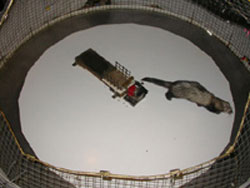Training improves sound localization in ferrets

Measuring the accuracy with which ferrets can localize sound. (Photo: King et al.)
Upon hearing the blare of a siren, you would quickly home in on the source and direction of the sound and take the necessary action, or precaution, such as pulling your car over or foregoing crossing the street until the ambulance has cleared. Mammals rely on sound localization skills to communicate, escape threats, and forage, among many other tasks. All through development the adult brain retains the capacity to rewire the networks that underlie these skills but it’s not clear which tasks benefit from plasticity or how the brain engenders this flexibility. In a study published in the open access journal PLoS Biology, Oliver Kacelnik, Andrew King, and colleagues showed by manipulating the hearing of adult ferrets that ferrets with obstructed hearing can quickly adapt to altered auditory cues when trained to do so in order to perform a necessary task. Their findings reveal that the frequency of the training was crucial in boosting the rate and extent of their improvement.
The brain processes spatial cues in the sound waves that enter each ear to localize sound and interprets sound on the horizontal plane by using disparities in how the sound reaches each ear, called interaural time differences and interaural level differences. Changes in level at different frequencies can reveal the source’s elevation.
To study adaptive hearing in an adult mammal, the authors blocked the left ears of ferrets with specially outfitted earplugs and measured their ability to localize sounds in the horizontal plane. They trained ferrets to approach a sound source to receive the reward. When the ferrets licked a waterspout, they triggered a burst of noise from one of twelve speakers. They were presented with sound bursts lasting either 1,000 or 40 milliseconds. Without earplugs, ferrets had no trouble localizing the sounds. They were slightly less adept at localizing the brief bursts. With earplugs, performance dropped considerably for both bursts. Ferrets had the most trouble with sounds coming for their left (obstructed) side, but errors increased significantly for all 12 sound sources. The authors retested one group of earplugged animals every six days to see if they could use the altered cues to recover their localization skills. By three weeks, the animals localized sound coming from the right side about as well as they had before the ear was plugged. The speed and accuracy with which the ferrets recovered their localization abilities depended on training, with more complete recovery when the animals received more frequent training.
To test the possibility that visual cues might help to boost auditory plasticity, the authors compared the earplugs’ behavioral effects on two groups of ferrets: one blind since infancy, and another with normal vision. Both groups could localize about the same without earplugs, made more errors after receiving the plug, and then steadily improved with the periodic retesting. These results show not only that the ferrets could be trained to reprocess abnormal localization cues but also that they could do so without visual cues. Then, by training another group of ferrets to localize both auditory and visual stimuli before inserting the earplug, the authors show that sound localization depends “exclusively on auditory training” and does not involve “a visual recalibration of auditory space.” Furthermore, adaptation did not depend on error feedback, since rewards were not based on performance.
After removal of the earplugs, ferrets made errors reflecting a small bias toward the previously plugged ear: they initially processed the cues as if the ear was still plugged. This aftereffect, though transient, indicates that the adaptive response relies in part on reinterpreting the relationship between binaural cues and location. However, compensation for the earplug-disrupted binaural cues mainly involved the animals’ learning to make use of other cues that were less distorted by the earplug, including low-frequency interaural time differences, and spectral cues provided by the unobstructed ear.
Altogether, these results show that the adult auditory system can adapt to abnormal spatial cues and can do so rapidly with intensive training. By recording brain activity as animals perform the tasks described here, future studies can shed light on the brain regions responsible for this plasticity. Whatever the mechanism, the finding that plasticity follows targeted, intensive training suggests that patients with hearing disorders might benefit from a similar strategy–providing more evidence that an old brain can sometimes learn new tricks.
Media Contact
More Information:
http://www.plosbiology.orgAll latest news from the category: Life Sciences and Chemistry
Articles and reports from the Life Sciences and chemistry area deal with applied and basic research into modern biology, chemistry and human medicine.
Valuable information can be found on a range of life sciences fields including bacteriology, biochemistry, bionics, bioinformatics, biophysics, biotechnology, genetics, geobotany, human biology, marine biology, microbiology, molecular biology, cellular biology, zoology, bioinorganic chemistry, microchemistry and environmental chemistry.
Newest articles

Bringing bio-inspired robots to life
Nebraska researcher Eric Markvicka gets NSF CAREER Award to pursue manufacture of novel materials for soft robotics and stretchable electronics. Engineers are increasingly eager to develop robots that mimic the…

Bella moths use poison to attract mates
Scientists are closer to finding out how. Pyrrolizidine alkaloids are as bitter and toxic as they are hard to pronounce. They’re produced by several different types of plants and are…

AI tool creates ‘synthetic’ images of cells
…for enhanced microscopy analysis. Observing individual cells through microscopes can reveal a range of important cell biological phenomena that frequently play a role in human diseases, but the process of…





















